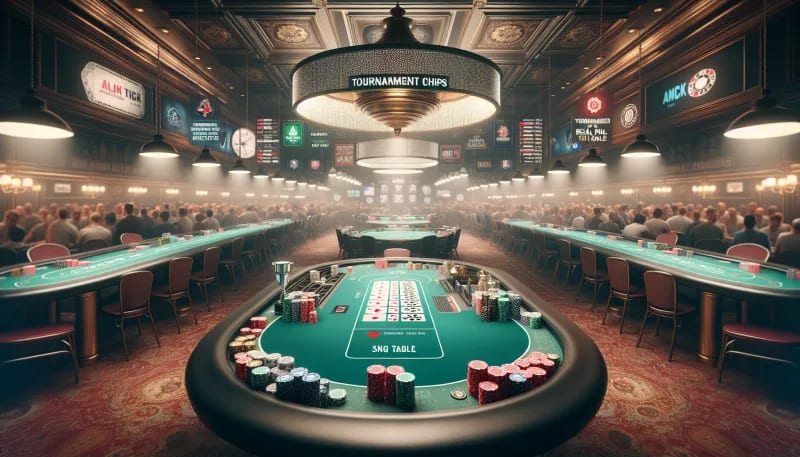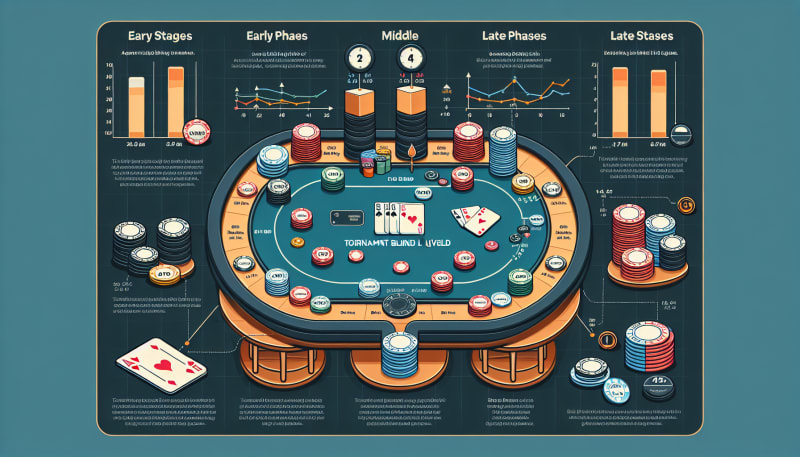Advanced Poker Tournament Strategy: From Early Stages to Final Table Tactics
Introduction to Poker Tournaments
Poker tournaments are a thrilling facet of the poker world where players compete for a collective prize pool. Have you ever wondered how they differ from your regular cash games? In cash games, the chips reflect real money, whereas in tournament play, you're armed with a stack of chips that has no cash value outside the game. Here, it's all about survival and strategy to outlast the competition.
A key difference lies in the escalating blinds. In tournaments, blinds increase after set intervals, pressuring players to act before their stacks are consumed by the ever-growing blinds. It adds an element of time that cash games lack, where blinds stay constant and you can theoretically play indefinitely. Do you feel the adrenaline rush just thinking about it?
Now, let's talk formats. Poker tournaments come in various shapes and sizes. Sit and Go tournaments are like the sprint races of poker. Usually single-table affairs, they begin once a predetermined number of players have taken their seats. The game is on, and the battle is swift.
Moving on, we have Multi-Table Tournaments (MTTs). As you may guess, these involve multiple tables with a horde of players vying for victory. It's a marathon, and the paths to glory require endurance, skill, and often a sprinkle of luck.
And then there are the big guns – large championship events. Think the World Series of Poker (WSOP) – a battleground where poker legends are born. Here, players from across the globe clash to etch their names in poker history. The stakes? Astronomical. The fame? Immortal.
As we wind down this segment, ask yourself, are you ready to dive into the diverse world of poker tournaments? With each format offering unique challenges and rewards, there's a tournament out there for every type of player. So, sharpen your skills and get ready, because next, we're diving into the heart of these competitions - the "Understanding Tournament Structure". It's where you’ll get a glimpse of what it takes to climb the tournament ladder to victory.
Understanding Tournament Structure
Building on what we've discussed in the 'Introduction to Poker Tournaments', let's zero in on how exactly these events are structured, shall we? I'm talking about the bones of the tournament: blind levels, antes, and stack sizes. The intricacies here can make or break your game.
First off, blind levels establish the pace. These are like ticking clocks, dictating urgency. In most tournaments, blinds increase at set intervals, escalating the minimum amount players must bet. It's what keeps the action moving. Imagine blinds starting at 100/200 chips and then, after a predetermined period, they jump to 200/400. This evolution is steady and non-negotiable, so don't get caught off guard.
Now, mix in some antes for extra spice. Antes are small, forced bets that all players contribute each hand, adding another layer to the pot right from the start. This mechanic encourages more aggressive play since there's always something worth fighting for in the middle. And when you think about it, isn't a poker tournament essentially a battle for chips?
Speaking of chips, stack sizes are king in this realm. Your stack dictates your might at the table. The deeper your stack, the more room you have to maneuver. A big stack can be a weapon, allowing for more risks and pressure on opponents. But a short stack? That's where strategy shifts, and your moves need to be sharp and decisive. No room for error. It's the survival of the fittest, but in chips.
Escalating blinds are the proverbial ticking time bomb. They force the action, pushing players to make moves before their stacks dwindle to nothing. As blinds soar, so does the pressure. Each bet, raise, or fold could be pivotal. How will you adapt when those blinds creep up? Here's a breakdown of how blind structures can vary across tournaments.
Now that we've dug into the mechanics, stay tuned for "Early Stage Tournament Strategy," where I'll dive into how to wield your chip arsenal wisely when the game's just begun. Remember, it's not just about playing the cards, it's playing the structure, and anticipation is your ally. Ready to schedule your battle plan around these shifting sands?
Early Stage Tournament Strategy
Transitioning from our deep dive into Understanding Tournament Structure, let's shift gears to the Early Stage Tournament Strategy. The early phases of a poker tournament can set the tone for the rest of your game. You've got a fresh stack and high hopes, but how do you best navigate this crucial time?
Think of it this way: Would you sprint at the start of a marathon? Probably not. Similarly, in a tournament’s infancy, playing conservatively is key. Why hammer away at a large stack when the blinds are as small as ants on the poker landscape?
Your chip stack is typically at its healthiest in relation to the blinds during the early stages. This means plenty of room to maneuver—no need to risk it all with marginal hands. Instead, prioritize strong starting hands and let go of marginal ones. This is not the time for wild bluffs or over-aggressive play.
Selective aggression is your friend. Keep an eye out for the right spots—loose opponents, positional advantages, and recognizing when your table image allows you to stretch your range a bit.
How about building a stack? Yes, patience is essential, but you also need chips to apply pressure later on. Take advantage when the pot odds are in your favor. Chip accumulation is a silent task—you're not looking to double up on every hand but to steadily increase your reserve.
Remember, not every pot is worth contesting. Ask yourself, does this hand improve my situation? If not, saving those chips could prove invaluable when the blinds start to soar. Picking battles wisely ensures you remain a threat when it really counts.
As you navigate through the early stages, keep these strategies in mind and prepare to adapt as you move toward the Middle Stage Tournament Strategy. Each phase welcomes a different approach, but mastering the early stages is fundamental in laying the groundwork for future success.
Maintain discipline, and stay tuned as we explore how your approach must shift when the middle stages beckon. Will you be ready to shift gears?
For more on tournament phases, check out this comprehensive guide to tournament strategy.
Middle Stage Tournament Strategy
Transitioning from the early stages of a tournament, where survival is key, to the middle stages, calls for a shift in gears. The name of the game now? Smart aggression. But how exactly do we gear up without risking too much of our precious stack?
Firstly, we need to keep an eye on the growing blinds and antes. They're big enough to hurt but also ripe for stealing. Consider this: wouldn't adding a few uncontested pots to your stack each round put you in a stronger position? Absolutely.
It's all about stack management. You don't want to be the short stack, but neither do you want to sleepwalk into becoming an average one. Stay above the fray. If you fall below twenty big blinds, it's time to look for opportunities to double up.
Position play becomes even more crucial now. From the late positions, I loosen up, attacking the blinds and antes more frequently. But remember, opponents are also shifting strategies. Are you observant enough to exploit their adjustments?
Defending your blinds is another topic up for debate. In the early stages, a tight approach is often recommended. But now? With stakes higher, I'm more likely to defend—but selectively. Pick your battles wisely.
Don't forget: it's not just about the chips. It's about the players. Who's got the nerves of steel, and who's starting to crack under pressure? Keeping tabs on the psychological battle can pinpoint your next move. Always ask yourself, which opponents are ripe targets, and who is better left untouched?
With the right mix of caution and controlled aggression, I position myself for the critical stages ahead. As we eye the Late Stage and Final Table Strategy, staying adaptable and vigilant in the middle stages lays the groundwork for clinching that top spot. Are you ready to step up your game when it truly counts?
Late Stage and Final Table Strategy
Transitioning from the middle stages of a tournament to the late stage and final table is where the real pressure kicks in. Your stack isn't just a stack anymore—it's your lifeline, your lever of power. And you better believe that every move counts.
How do you use that power? Aggression. It's essential here, more than ever. I'm not saying you should throw caution to the wind—far from it. But I am suggesting a calculated, controlled aggression that capitalizes on the heightened tension and increased blinds. Remember, the players here are battling for significant money jumps. So picking your spots is key.
And reading opponents? That's your bread and butter in this phase. I take it a step further, leaning heavily on the intel gathered during quieter times. You've been studying your opponents, haven't you? If you have, now is the time when that all pays off. Each player's tells, their betting patterns, their thresholds for risk—it all helps in tailoring your strategy to steal blinds and protect your stack.
But here's a tip: stay dynamic. As the table shortens, your approach should shift. Hands that were foldable nine-handed can suddenly become gems when you’re four-handed. It's a smaller table, so you'll play more hands — and they won't all be Aces.
Let me ask you, have you ever felt the rush of outmaneuvering an opponent with a perfectly timed bluff? Imagine doing that with a title, a bracelet, or a six-figure cash on the line. That's the energy you need to bring. But bring it smartly; overplaying a weak hand or underestimating a silent assassin can cost you dearly.
Mind the dynamics. The fewer the players, the more each chip is worth, and every blind you lose or gain means more than it did an hour ago. It's a delicate dance between conserving your stack and amassing more chips. Stay alert, adapt fast, and keep your finger on the pulse of the game.
You see, the late stage isn't just about surviving; it's about thriving under pressure. And as you eye those top spots, ask yourself, can you turn the screw when it counts? Are you ready to outwit and outlast your rivals when the spotlight shines brightest?
Now, you've got your late-stage strategy dialed in. But what about adjusting to different types of opponents? Whether they're aggressive sharks or cautious minnows, navigating this menagerie of player styles is up next.
Adjusting to Different Types of Opponents
Building on the strategies discussed for the late-stage and final table play, let's talk about tailoring our game against various opponents. We all know, poker isn’t just a card game; it’s a game played against other people. And each person comes with a unique playstyle.
Aggressive Players
Facing down aggressive players? Keep your cool. It's easy to get rattled, but that's exactly what they want. Got a hand worth playing? Don’t be afraid to push back when the odds are in your favor. Here's something I always ask myself: Am I in control of the pot size? With bullies, you want to either take control early or let them inflate the pot when you’re holding strong cards. Sometimes, standing up to the aggressor can throw them off balance. When they barrel into pots with reckless abandon, wait for your moment and then strike decisively.
Tight Players
Tight players are like a vault - tough to crack, but not impenetrable. How do you deal with them? Patience and position. Stay disciplined and when you have position, apply pressure by widening your opening range. This can often push them out of pots pre-flop. However, remember that a tight player’s range is narrow for a reason – when they do enter a pot, be ready to give them credit for a strong range.
Recreational Participants
Recreational players are here for fun and their play can be unpredictable. Ever noticed how they often disregard poker probabilities? This is where you can cash in. Position is your best friend against them. Use it to control the action and to make more informed decisions post-flop. Always adapt to their loose play and avoid complex bluffs; keep things straightforward and value bet your strong hands heavily. Want some homework? Brush up on your hand reading abilities here. It's a surefire way to enhance decision-making against recreationalists.
As you approach the nuances of bankroll management detailed in the next section, remember this: your playbook against different opponent types is just as crucial. Adjusting your game isn't just smart, it's profitable. Let's not just play the cards we're dealt; let's play the people across the table. Will your adjustments make the difference between busting out and cashing big? It's all in the adaptation.
Bankroll Management for Tournament Play
Navigating the unpredictable waters of tournament play, I've learned that bankroll management isn't just a safety net—it's the lifeblood of a poker career. Why? Because tournaments are a high-variance beast.
Variance in poker is the statistical measure of how your results can differ from the expected outcome. In tournaments, you might go through long stretches without a significant cash, despite making all the right moves. It’s the reality of the game. But with a solid bankroll strategy, you can weather these dry spells and stay in the game.
When we talk ROI, or Return on Investment, we're measuring the percentage of profit made on your buy-ins. It’s a clear indicator of whether you're playing profitably over the long haul. Say you're cashing in often, but only for min-cashes, your ROI could still be low – a sign you might need to review your strategy.
Now, what about picking the right buy-ins? It's a dance between aiming for lucrative payouts and not overextending your bankroll. Experts often suggest having at least 100-200 buy-ins for the level you're playing. Entering a tournament that costs more than 1-2% of your total bankroll? That could be a fast track to busto city.
So, how do you strike that balance between risk and reward? It's essential to continually assess your game. Are those higher buy-in tournaments really where your best edge is? Or are you more profitable grinding out lower stakes where you can enter more tournaments and reduce your variance?
Keeping your bankroll healthy gives you the flexibility to adjust strategies and tackle different types of opponents, seamlessly connecting to our previous discussion. And remember, as you level up in stakes, integrating advanced concepts from the upcoming section will be crucial to staying profitable.
In the end, it's a simple truth: manage your money wisely, and the cards will often fall into place. But flout this principle, and no amount of skill can save you from the inevitable downswing. Stay disciplined, and you'll see how bankroll management is the silent partner to every tournament success story.
Advanced Concepts in Tournament Poker
Moving on from bankroll management, let's dive deep into the strategies that separate the pros from the amateurs in tournament play. Have you ever found yourself wondering how the top players make decisions that seem counterintuitive yet work out more often than not? That’s because they apply advanced concepts such as ICM, understand the intricacies of bubble play, and have honed their heads-up strategies.
First up, let’s talk about the Independent Chip Model (ICM). It's a mathematical approach that can transform your end-game. Ever considered how your chips are worth more than just their face value? The ICM gives them a dollar amount based on your stack's equity in terms of the overall prize pool. Making a deep run in a tournament? The ICM should be guiding your decisions. Here's a primer on ICM that could be the game-changer for your finishes.
Moving onto bubble play, which can be as nerve-wracking as it is critical. The key here is to assess your opponents’ tendencies. Who is feeling the pressure to sneak into the money, and who is playing fearlessly? It's a prime time for you to exploit conservatism or apply pressure to chip stacks teetering on the brink.
Lastly, we can't overlook heads-up strategies. When you find yourself one-on-one for all the marbles, do you know how to adjust your range? Are you aware of how to switch gears and keep your opponent on their toes? Dominating heads-up play is about aggression, sure, but it’s also about pattern recognition and psychological warfare. Think you've got what it takes to outmaneuver your opponent at this stage? Improve your heads-up game with these strategies.
Each of these topics could fill volumes, but integrating them into your repertoire is essential for scaling the mountain of tournament poker. Remember, it's not just about the cards; it's how you play them that counts. As we wrap up this discussion, reflect on how these concepts can elevate your game. There is no magic bullet, but consistent application of these advanced strategies will set you apart. Keep practicing, keep learning, and may the flop be with you.








